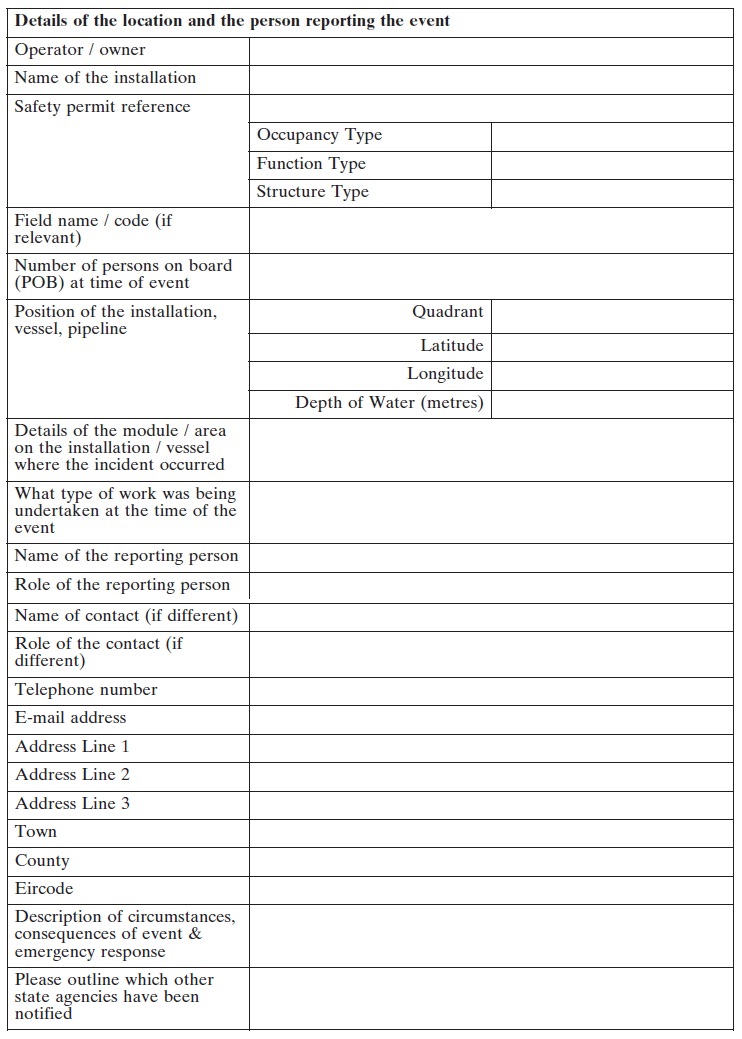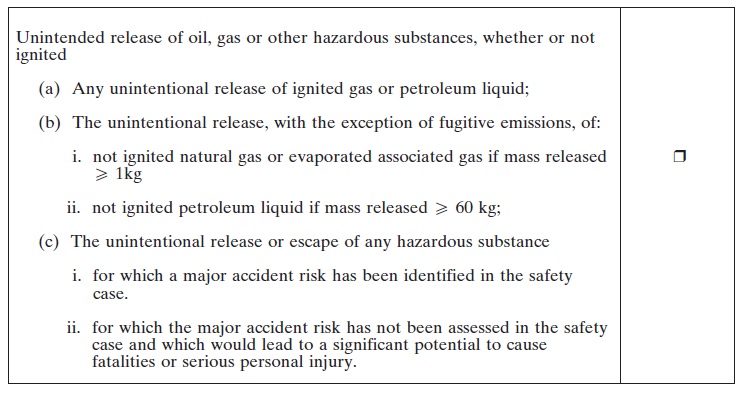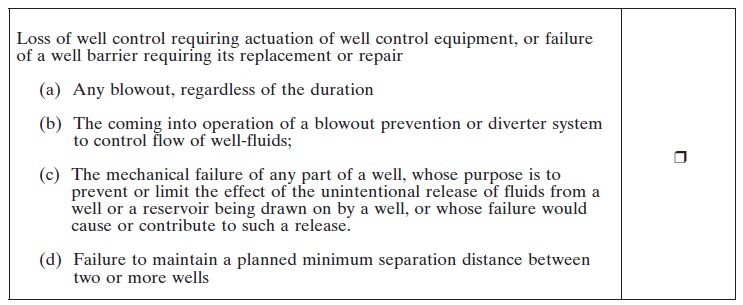S.I. No. 81/2016 - Petroleum Safety (Petroleum Incident) Regulations 2016.
Notice of the making of this Statutory Instrument was published in | ||
“Iris Oifigiúil” of 1st March, 2016. | ||
The Commission for Energy Regulation in exercise of the powers conferred on it by Section 13V Electricity Regulation Act 1999 (as inserted by Section 18 of the Petroleum (Exploration and Extraction) Safety Act 2015 ), hereby makes the following regulations: | ||
Citation | ||
1. These Regulations may be cited as the Petroleum Safety (Petroleum Incident) Regulations 2016. | ||
Commencement | ||
2. These Regulations shall come into operation on 29 February 2016. | ||
Revocation | ||
3. Regulations entitled Petroleum Safety (Petroleum Incident) Regulations 2014 ( S.I. No. 4 of 2014 ) are hereby revoked. | ||
Saver | ||
4. Petroleum Safety (Petroleum Incident) Regulations 2014 shall remain in force for the purposes of dealing with an incident or incidents reported or reportable thereunder for the purpose only of dealing with that incident or incidents. | ||
Interpretation | ||
5. In these Regulations, unless the context otherwise requires— | ||
‘Act of 1960’ means the Petroleum and other Minerals Development Act, 1960 as amended; | ||
‘Act of 1976’ means the Gas Act, 1976 ; | ||
‘Act of 1999’ means the Electricity Regulation Act, 1999 , as amended; | ||
‘Act of 2015’ means the Petroleum (Exploration and Extraction) Safety Act, 2015 ; | ||
‘Commission’ means Commission for Energy Regulation or such title as it may become known by; | ||
‘contractor’ means any entity contracted by an operator or owner to perform any activity on behalf of the operator or owner; | ||
‘defined geographical area’ means the standby vessel’s assigned area of operation which allows the standby vessel to provide rescue and recovery arrangements within the required response times, as set out in the performance standards; | ||
‘designated petroleum activity’ means a petroleum activity which is designated by Regulations made under Section 13D of the Act of 1999; | ||
‘Environmental Liability Regulations’ means European Communities (Environmental Liability) Regulations 2008 ( S.I. No. 547 of 2008 ) (as amended by the European Communities (Environmental Liability) (Amendment) Regulations 2011 ( S.I. No. 307 of 2011 )); | ||
‘installation’ means the class of petroleum infrastructure which includes a stationary, fixed or mobile facility, or combination of facilities permanently inter-connected by bridges or other structures, used for carrying out activities or in connection with such activities; | ||
‘hazardous substance’ means a substance or a mixture fulfilling the criteria relating to physical hazards, health hazards or environmental hazards, laid down in Parts 2 to 5 of Annex I of European Regulation 1272/2008 as amended; | ||
‘major accident’ for the purpose of these Regulations shall include the following— | ||
(a) an event involving an explosion, fire, loss of well control, or | ||
release of oil, gas or dangerous substances involving, or with a significant potential to cause, fatalities or serious personal injury, | ||
(b) an event leading to serious damage of petroleum infrastructure involving, or with a significant potential to cause, fatalities, or | ||
serious personal injury, | ||
(c) any other event leading to fatalities or serious injury to multiple persons, or | ||
(d) any major environmental incident resulting from incidents referred to in paragraphs (a), (b) and (c) and which relates to petroleum activities carried out offshore; | ||
‘major environmental incident’ means an incident which results, or is likely to result, in significant adverse effects on the environment in accordance with the Environmental Liability Regulations; | ||
‘non-production installation’ means the class of installation involved in carrying out offshore petroleum exploration or other designated petroleum activity or activities whilst stationed in the licensed area, but does not include installations involved in production of petroleum; | ||
‘offshore’ means situated in the territorial seas, the exclusive economic zone or as defined by the Act of 2015 and includes a designated area designated by order under Section 2 of the Continental Shelf Act 1968 ; | ||
‘operator’ means the entity appointed under Section 13KA(1) of the Act of 2015 to conduct designated petroleum activities including managing and controlling the functions of petroleum infrastructure (except non-production installations) in carrying out petroleum activities; | ||
‘owner’ means a person entitled to control the operation of a non-production installation; | ||
‘petroleum’ includes— | ||
(a) any mineral oil or relative hydrocarbon and natural gas and other liquid or gaseous hydrocarbons and their derivatives or constituent substances existing in its natural condition in strata (including, without limitation, distillate, condensate, casinghead gasoline and other substances that are ordinarily produced from oil and gas wells), and | ||
(b) any other substance contained in oil and natural gas brought to the surface with them in the normal process of extraction, | ||
but does not include coal and bituminous shales and other stratified deposits from which oil can be extracted by distillation; | ||
‘petroleum authorisation’ means any one or more of the following: | ||
(a) an exploration licence granted under Section 8 of the Act of 1960; | ||
(b) a petroleum prospecting licence granted under Section 9 of the Act of 1960; | ||
(c) a reserved area licence granted under Section 19 of the Act of 1960; | ||
(d) a lease undertaking granted under Section 10 of the Act of 1960; | ||
(e) a petroleum lease granted under Section 13 of the Act of 1960; | ||
(f) a consent given under Section 40 of the Act of 1976; | ||
‘petroleum incident’ means an event or occurrence in, at or in the precincts of petroleum infrastructure of class prescribed in Regulation 6; | ||
‘serious injury’ means: | ||
(a) an injury to a person where the person cannot perform all of their normal work activities for more than 7 consecutive days (not including the day of the petroleum incident, but including subsequent non-working days); or | ||
(b) any injury to a person that requires admittance to a hospital for more than 24 hours; | ||
‘third party property’ means property the ownership of which is held by a person other than the petroleum undertaking, operator or owner concerned, or of contractors or subcontractors to that petroleum undertaking, operator or owner that are carrying out work in connection with a designated petroleum activity; | ||
6. The following classes shall be a major accident event or incident which may materially increase the risk of an event or occurrence referred to in Section 13U(1)(a) to (d) of the Act of 2015 occurring that is a petroleum incident and should be read in conjunction with the Commission Guidance for Notification of Incidents for the time being- | ||
Class A Unintended release of oil, gas or other hazardous substances, whether or not ignited; | ||
Class B Loss of well control requiring actuation of well control equipment, or failure of a well barrier requiring its replacement or repair; | ||
Class C Failure of a safety and environmentally critical element; | ||
Class D Significant loss of structural integrity or loss of station keeping in relation to a mobile installation; | ||
Class E Potential and actual vessel collisions with an offshore installation; | ||
Class F Helicopter accidents within the safety zone; | ||
Class G Any fatality; | ||
Class H Any serious injury; | ||
Class I Any evacuation of personnel; | ||
Class J Any major environmental incident (offshore); | ||
Class K An uncontrolled fire or explosion; | ||
Class L Instance of a stand-by vessel not being within its defined geographical area, except when prevailing weather and climate conditions may endanger the crew, passengers or vessel; | ||
Class M A person falling into the sea; | ||
Class N Mustering on onshore or offshore petroleum infrastructure, other than for planned drills; | ||
Class O The detection of hydrogen sulfide in the course of operations at a well or in samples of well-fluids from a well where the presence of hydrogen sulfide in the reservoir being drawn on by the well was not anticipated; | ||
Class P The collapse, overturning, or failure of any load-bearing part of any lift, hoist, crane, or derrick; | ||
Class Q Damage to third party property; | ||
Class R The dropping of an object that could have resulted in a major accident; | ||
Class S A collision by a vehicle, crane, or aircraft with any petroleum infrastructure. | ||
7. The prescribed form of notification of a petroleum incident to be used by an operator or owner shall be in the form set out in Schedule A hereto and shall contain the following classes of information: | ||
a. General | ||
b. Owner/Operator Details | ||
c. Event Categorisation | ||
d. Further Requirement | ||
e. For Commission Office Use Only | ||
8. In these Regulations— | ||
(a) a word or expression that is used in these Regulations and is also used in the Act of 1999 has, unless the contrary intention appears, the same meaning in these Regulations as it has in the Act of 1999; | ||
(b) where a word or expression is given a meaning in the Act of 1999 or in these Regulations then, except where the context otherwise requires, any cognate word or expression used in these Regulations shall be construed accordingly; | ||
(c) a reference to an article or schedule is to an Article of, or Schedule to, these Regulations, unless it is indicated that reference to some other provision is intended; and | ||
(d) a reference to a paragraph is a reference to a paragraph of the provision in which the reference occurs, unless it is indicated that reference to some other provision is intended. | ||
| ||
Schedule A | ||
PRESCRIBED FORM TO BE USED FOR NOTIFICATION OF PETROLEUM INCIDENT TO BE USED BY AN OPERATOR OR OWNER | ||
To be completed and submitted to the Commission without delay. | ||
Failure to notify the Commission of a petroleum incident without delay is an offence under Section 13S of the Electricity Regulation Act 1999 . | ||
For guidance on what constitutes a petroleum incident, please refer to the Petroleum Safety (Petroleum Incident) Regulations 2016 and the Commission Guidance for Notification of Incidents. | ||
| ||
GENERAL | ||
| ||
| ||
OWNER/OPERATOR DETAILS | ||
| ||
EVENT CATEGORISATION | ||
What class of event is being reported. (More than one option A to S may be applicable) Please select all relevant classes. A single incident may result in multiple parts to be completed. If any boxes are selected in this form then the detailed report of each selected class needs to be completed. | ||
Class A— | ||
| ||
Class B— | ||
| ||
Class C— | ||
| ||
Class D— | ||
| ||
Class E— | ||
| ||
Class F— | ||
| ||
Class G— | ||
| ||
Class H— | ||
| ||
Class I— | ||
| ||
Class J— | ||
| ||
Class K— | ||
| ||
Class L— | ||
| ||
Class M— | ||
| ||
Class N— | ||
| ||
Class O— | ||
| ||
Class P— | ||
| ||
Class Q— | ||
| ||
Class R— | ||
| ||
Class S— | ||
| ||
| ||
FURTHER REQUIREMENT | ||
Detailed Reports | ||
A detailed incident report (a copy of which can be found on the petroleum safety section of the Commission website) shall be completed by the owner/operator and submitted to the Commission within 10 working days. | ||
Fatality(ies) or missing person(s) | ||
In the case of a petroleum incident which results in a fatality or a missing person, the operator and/or owner must notify the Commission, by the quickest practicable means, for instance by phone, of: | ||
• The name of the deceased or missing person(s); | ||
• Brief particulars of the petroleum incident; and | ||
• The location of the petroleum incident. | ||
The requirement to notify the Commission using this notification is in addition to the requirements to notify the Commission using this notification Petroleum Incident Notification form as normal, without delay and within 10 days of the incident respectively. | ||
FOR COMMISSION OFFICE USE ONLY | ||
| ||
| ||
Sealed with the common seal of the Commission forEnergy Regulation on the 24 February 2016. | ||
| ||
GARRETT BLANEY, | ||
Chairperson of the Commission. | ||
EXPLANATORY NOTE: | ||
(This note is not part of the Instrument and does not purport to be a legal interpretation) | ||
The Regulations are made for the purpose of enabling Part of the IIA of the Electricity Regulation Act, 1999 as amended and prescribing the class of event for the purposes of defining a petroleum incident, the class of event or occurrence which in the opinion of the Commission constitute a major accident or may materially increase the risk of an event or occurrence referred to in Section 13U occurring and for prescribing the class of event or occurrence to enable the Commission discharge its reporting obligations to the European Commission and to prescribe a form to be used and details to be given by operators or owners to notify the Commission of a petroleum incident. |























